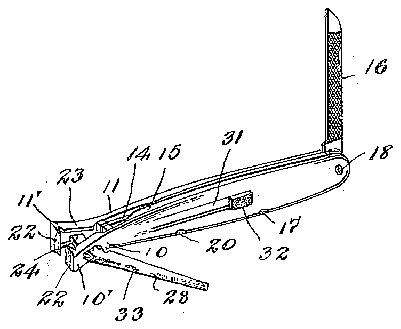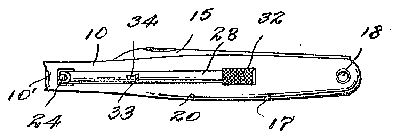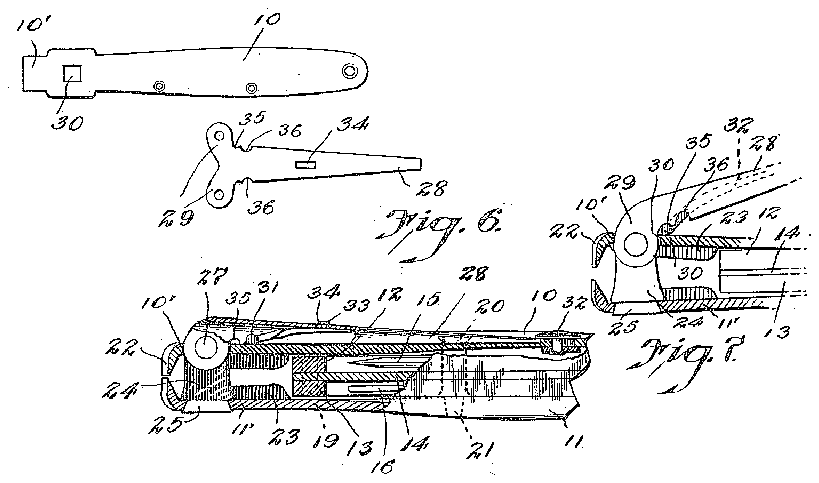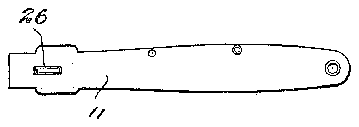



- 1plates
- 2y
- 10plates
- 11plate
- 12springs
- 13springs
- 14lining plate
- 15blades
- 17rivet
- 18pivot
- 20plate 10 only asat
- 21tenon
- 22blades
- 23reinforcing flanges
- 24stud
- 25tenon
- 26aperture
- 27pin
- 28lever
- 29ears
- 30aperture
- 32stem
- 33head
- 35outer notch
- 36notches
- 42 l
- 82stem
- 322serial number
- 981serial number
Description
A. F. BLANCHARD.
COMBINATION POCKETKNIFE AND NAIL CLIP.
APPL|CATI0N FILED nmz. 1920. REM-:WED N0v.30,1921.
l 42%,551 Patented Aug. 1, 1922.
gunman/(oz attenua?,
saires stares saresti certes.
ADNA F. BLANCHARD, OF CRANSTO'N, RHODE ISLAND, ASSIGNOR, BY MESNE ASSIGN- MENTS, TO- FAIR'FXELD MANUFACTURING vCOMPANY,y OF CRANSTON, RHODE ISLAND, a #CORPORATION COMBINATION rooiiniNNIrE aNnk NAIL CLIP.
i,seassi.
Continuation in part of application Serial No. 322,981, filed September 10, 1919.
' Specification of Letters Patent.
Patented Aug. 1, 1922.
This application iled Apri1-`2,1920, Serial No. 370,753. Renewed November 30, 1921. Serial No. 519,03.`
To @ZZ wim/m t may concern:
Be it known that l, AUNA F. BLANCHARD, a citizen of the United States,-residing at Cranston, in the county of Providence and State of Rhode island, have invented certain new and useful improvements in Combination Pocketknives and Nail Clips, of which the following is a specication.
This application is a continuation in part of my cofpending application filed September 10, 1919, Serial Number 322,981.
The invention has for an object to provide a combination pocket knife and nail clip, in which there are utilized well known elements of pocketl knives in such a manner that the cheek plates or handle por tions may be utilized as clip devices for clipping finger nails and the like. 1t is a further important aim of the invention to eifect improvements in` such va device whereby the clipping action will be made quite easy by the provision of means which will increase the leverage of the arm by which the clip portion is operated, and whereby in the closing of the device, when not in use. excessive pressure upon the clipping blades is obviated as wellv as ease in. closing the device attained. f
.Additional objects, advantages and features of invention will. appear from the construction, arrangement and combination of parts hereinafter described and shown in theV drawings presenting one embodiment' of thek invention, wherein,
Figure 1 is a perspective view of an implement constructed in accordance with my invention, in open position7 Fig..2 is a side elevation thereof,- closed, Fig. 3 is an enlarged longitudinal sectional view of the operative parts at the j clipl end,
' fulcnum member.
springs, there being no lining plate at the outer sides cf the device beneath the plates 10 and 11, in the present instance. Blades 15 and 16 are pivoted in a usual manner at" i one end of the device between the plates 10 and' 11; the blade 16 is a nail file and cleaner. i f
lt should be noted that the springs 12 and 13 are not secured between the plates 10 and 11 at the end opposite the pivot in the blade in the usual manner familiar in the art, and the plates 1() and 11, which correspond to the ordinary lining plates, are projected slightly beyond the springs and middle lining plate at that end of the device opposite the pivot of the blades. The springs and plates are secured together by an intermediate rivet 17 having the usual location with respect to the pivot 18 of the blades, but
'the extremities of the springs opposite the pivot are not secured to the outer plates at all, although they may be secured' together upon the lining plate 14 as indicated at 19. 1n the present case, the second point of securement of the spring to an outer member is at 20, a point intermediately of the rivet 17 and the ends of the springs opposite the blade pivot. This'securement may beof an ordinary character, which would. leave the plates 10 and 11 free for relative flexure from this point outwardly on their adjacent extremities. But, in 'the present instance, I have shown the springsas riveted to the plate 10 only asat 20, but the rivet is` formed: with a taper tenon 21 loosely in a recess or aperture in the plate 11. By this construction the plate 11 is permittedV relative movement from its point of. secui'ement at 17, and the vplate 11' is supported against the ordinary stresses to which it would' be subjected as a part of a knife handle by the pivot '18 and the tenen 21, in addition to the rivet 17.
The extensions of the handle plates 10 and 11 are provided with nail clip jaws or blades 22, a short distance outwardly of the springs, and reinforcing flanges 23 are formed on each side of these extensions proinserted jected inwardly and extending throughout thelength of the extensions. The extensions of the plates 1()l and 11 to form the clips may be termed clip jaws 10 and 11', respectively. lt should be noted that the plates are given a set causing these jaws to tend to incline outwardly from each other toward their outer ends, and that the plate 11 may diverge from the knife springs be-v ginning at the rivet 17 and extending over a major 'part of the length of the knife handle.
ln the jaw 11 there is iset a stud 24, having a tenon 25 projected through an aperture 260i rectangular form. extending longitudinally of the jaw countersunk on the outer side. rrlhe tenon 25 is peened in this aperture, so as to form a dove-tail connection.
' rlhe stud is stamped from sheet metal, and
the tenon25 may be formed by notching the` base of the stud at opposite corners, the
j intermediate portion of this tenon being the full thickness of the blank and adapted to iit snugly between the sides of the aperture 26 vwhen inserted. The stud is provided at its outer end with a transverse pin 27, the axis of which is inthe present instance between the jaws when in open position as y shown in Fig. 7. Pivoted Aupon this pin there is a lever 28 formed from a blank of sheet metal bent vinto U-shape in' cross section,
provided with ears 29 at each side, mounted upon the pin 27, these ears being projected laterally from the lever in parallel relation and being engaged through an aperture 30 c formed in the plate 10 having proper dimensions to receive the parts loosely, for the yfunction to bedescribed. The inner longitudinal edges ofthe lever are so extended as Ato lie flat upon .the plate 10 and within a recessed portion 31 n thereof when the two plates have been moved inwardly toward each other until the blades 22 nearly or quite engage, and sliding latch 32 is provided I to engage over the end of the lever when in this positionjto hold the parts in closed relation. By, having the tenon 21 slightly 5e y Y, used for cutting with the blade, liability of tapered, when the parts are forced` inwardly into this position, the plate 11 will fit tightly upon the tenon so that when the device `is loose movementfof the plate 11 will be obviated. It is believed, however, that the pivot 18 and rivet 17 are sufficient inthemselves for this purpose.
The? devicemightbe utilized in this form rasv a nail clip, but in order tov provide for Y proper clipping coaction between the blades 22, and also togive a shiftable fulcrum for the device whereby the vfulcrum will ybe as near as possiblel to the pivot of the lever, or
lotherwise located for the most efficient appli- `cation ofV Vforce through the lever, I have provided in the lever a longitudinallyshiftable fulcrum 31. This lfulcrum `consists of a transverse bar from which there lis ex- `tended at right angles a stem 32 laid within j the lever close to the bightportion,as viewed in cross section, and having a lateral 'ishaped extension 33 at one side, the head portion of vwhich is inserted through a slot' 34 formed medially in the lever, the head portion extending transverselyof thev slot so as to hold the fulcrum device in place. rihe retaining 'portion 33 is put in position by first twisting the stem 82 ,adjacent the bar 3i for a quarter turn, and after inserting the member 33 through the slot 34C, the
head portion is given a quarter turn twist also, to set it transversely of the slot. For the functioning of the fulcrum, the lever is provided Awith two notches next to the jaw l0 oneach edge close to the ears 29. The outer notch 35 is a shallow one, while the notch further from the ears is a deep one 36 and is adapted to receive the ends of the fulcrum bar 31 loosely when the parts are in closed position as shown in Fig; 3, or the notch may be so shaped that the fulcrum will be borne against the jaw 10 so as to hold the parts .in the position shown in Fig.
8, or such other positionasy may be deterclear theV lever which vis then thrown outy wardly by opening action of the jaws. The
`fulcrum bar' will at this time be in the notches 36, and the shifting head 33 on the stem of the lever will beat the inner end of the slot 3e, with respect to the knife handle. The head 33 is adjusted with suiiicient'loose movement to permit the fulcrum member 31 to fall below the notches 36 when't-he lever is raised, or the stem 32 may be made resilient so that when pressure'is exerted upon 'the head 33 to cause it to slide' outwardly upon the leverthe fulcrum member will be moved from the notches'36 into the notches In order ,for the fulcrum to engage un der the notches'l it isV necessary to raise the lever to a considerable height.- 'Upon downward pressure of the lever then, the -jawsare readily compressed into contact, and it is easy to apply suiiicient pressure to clip a nail. 4 4
The plates 10 1:1 [may be-.pressed into i form with their intermediate parts pressed outwardly, so as to give a good rounded handle, therein'in case they are stamped from sheet metal, and the channel 31 may be cut or pressed in the plate l0, as found most desirable.
lNhat is claimed:
l. A combined pocket knife handle and nail clip comprising a handle body including resilient lining plates, a knife spring secured to the plates a distance from the pivot and secured to one plate a greater distance from the pivot short of the end of the spring body, said plates tending to diverge beginning intermediately of the handle, said plates being projected beyond the spring a distance and formed as clip devices, and means to compress the clip devices. y
2. ln a combined knife and clip a handle body including resilient longitudinally eX- tending plates and interposedknife springs, said plates projected beyond the handle body at one end and formed thereat as clips, means to compress the clip portions, a connection between said plates intermediately of the handle one plate being fixed to the knife spring at a lesser distance from the clips and a pin snugly slidable in the other there adjacent wherebyit may flex and will be sustained as a handle element.
3. lin a device of the character described, relatively movable clip jaws, a lever to voperate the jaws having a release position and a longitudinally shiftable fulcrum member thereon, said lever being notched and said fulcrum being movable to engage in said notch for inoperative relation of the parts.
et. In a clip device a pair of relatively movable clip jaws, one having a stud mounted thereon, the other apertured adjacent the ing a longitudinally slidable stem mounted therein having a transverse fulcrum member at one end and notch portions in the lever to engage the fulcrum at different positions, the lever being connected to one element of the clip and said fulcrum having bearing on the other member of the clip. p'
6. In a combination knife and clip, a knife handle body including two blademounting plates of resilient metal' suitable for a cutting tool, said plates being extended beyond the handle body at one end andy shaped to form clip jaws relatively movable toward and away from each other, and having a set tending to spring them apart, and means to compress the jaws for clipping action including a lever extending inwardly beside the handle body.
In testimony whereof l have aiiixed my signature in presence of two witnesses.
ADNA F. BLANCHARD.
Witnesses SAMUEL H. CRENSTEIN, JAMEs H. DoonLEY.